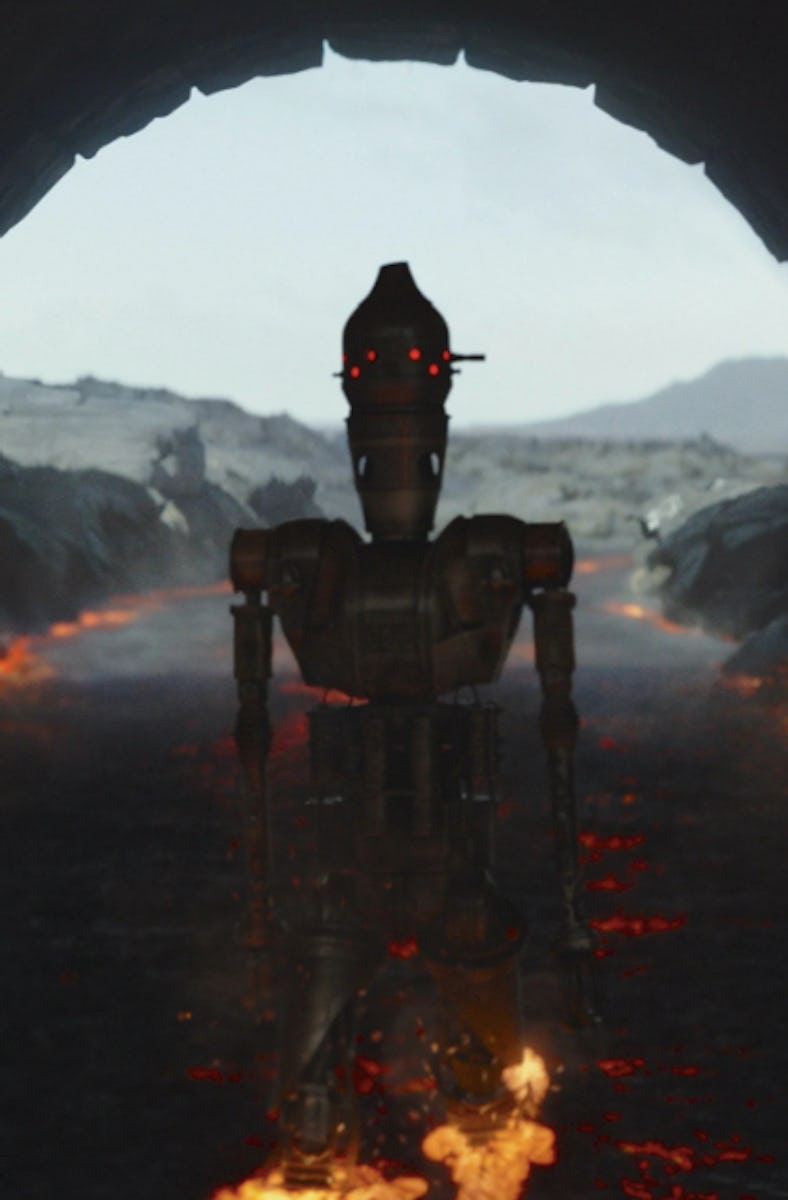The Mandalorian Season 3’s Dumbest Side-Quest Matters More Than You Think
IG-11 and Din Djarin have a surprising amount in common.

Your standard cult uses religious doctrine and dogma to isolate people and control them. Once a person is in, they begin to lose their individuality. The cult essentially “programs” a person with a set of rules, incentives, and punishments. This programming goes deep, and it’s hard to break free.
Din Djarin has had a busy last few years. He adopted a son, slayed literal dragons, and accidentally became a prime candidate for the leadership of Mandalore. He’s grown as a person, but his cult upbringing still has a hold on him. In The Mandalorian Season 3 Episode 1, this “programming” is cleverly paralleled in IG-11.
The Return of IG-11
IG-11 in The Mandalorian.
In Chapter 17, Mando returns to Nevarro with the intent of resurrecting his friend, the former assassin-turned-nurse who saved Din’s life twice, IG-11. In The Mandalorian Season 1, Mando learned an essential lesson from the late Kuill about programming. IG-11 was a lethal assassin who wouldn’t hesitate to murder Grogu, but Kuill carefully reprogrammed and trained the droid to become a nurse and companion. Mirroring Din’s arc, IG-11 was no longer a hunter, but a protector.
Sadly, when Din reactivates the remains of IG-11, the droid reverts to its assassin programming and lunges at Grogu. But Din refuses to give up on his friend, launching an interstellar quest to find a new memory circuit to repair him; a missing piece that can bring back his friend.
The Children of the Watch
The Armorer and Din Djarin in The Mandalorian.
Like IG-11, Din is also a victim of his programming. He was saved by Mandalorians as a child after being orphaned during the Clone Wars. He became a foundling in the group known as “The Children of the Watch,” an offshoot of Mandalorian culture. Initially, it seems like he has found the perfect home, but as we learn more about the Watch, we see the restrictive nature of their traditions.
In The Mandalorian Season 3’s opener, Din is on a quest to redeem himself for the crime of removing his helmet. He didn’t callously break this rule. Din only showed his face the first time during a mission to save Grogu, and the second time he removed his helmet was to say goodbye to Grogu, face to face. He wanted the person he loved to see who he was behind the mask. The tear-jerking scene shows that he’s willing to break the rules for the ones he loves.
Sadly, Din is so programmed that he’s trying to atone for his expression of love. The quest given to him by the Armorer seems less like redemption and more like proof of his devotion to the cult. The Armorer is not trying to redeem him, she’s trying to retain power over him.
IG-11 and Mando
IG-11 in happier times.
IG-11 reverted to his programming the moment the proverbial lights came back on. Despite all the changes in his character in the first season, his original programming is still there. Din Djarin is a victim of the same weakness. He has grown through Seasons 1 and 2, becoming more independent from the Children of the Watch. He is no longer just “The Mandalorian.” He has an identity.
The quest to redeem himself in the Mines of Mandalore feels like a regression of his progress. Din is falling back into his programming, blindly following the cult’s rules and atoning for his supposed sins. But there is hope for Din. Like IG-11, he just needs the right pieces to free him. And those pieces may already be within reach.
The way I see it, Din’s missing parts are his friends, family, and the people he has met along the way. All those “fetch missions” were him collecting the pieces he needed to eventually break free of his programming and choose his own destiny. Hopefully, in The Mandalorian Season 3, both Mando and IG-11 can become whole again.